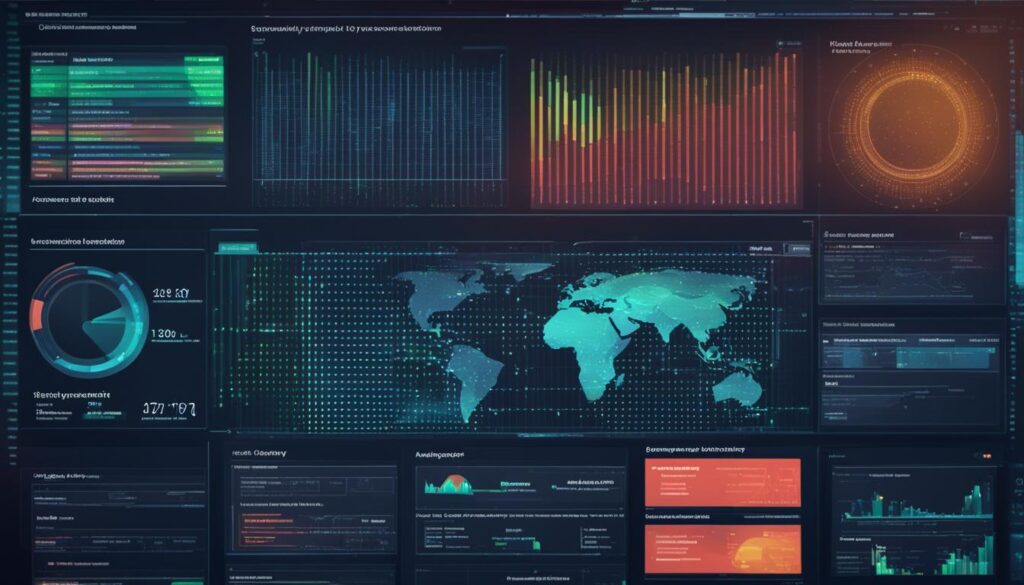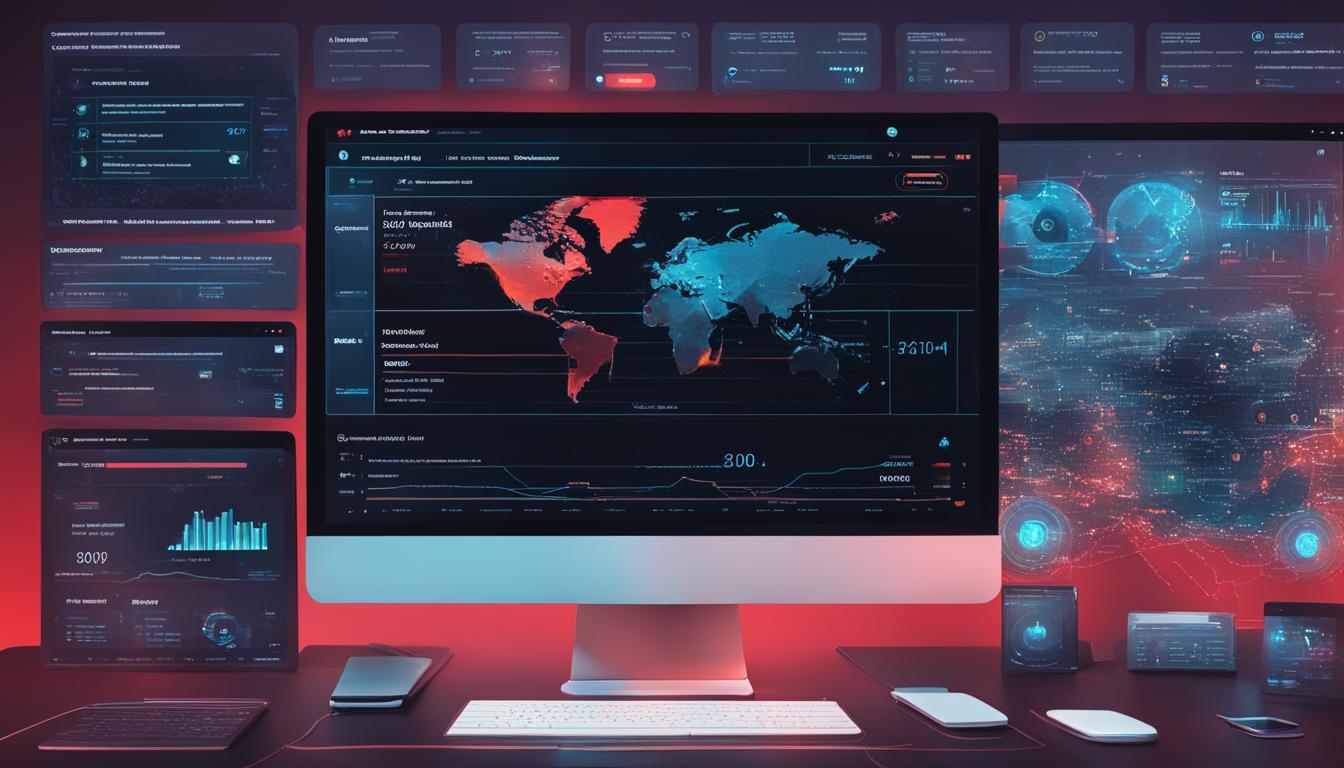Welcome to our spotlight on the benefits of utilizing artificial intelligence in cybersecurity. In today’s digital landscape, companies face increasingly sophisticated and changing cyber threats that endanger sensitive data and could disrupt business operations. In tackling these issues, artificial intelligence is emerging as a vital tool in the area of cybersecurity, offering a wide range of advantages in identifying threats, reacting to breaches, and improving security protocols overall.
In this article, we will explore how AI is revolutionizing the field of cybersecurity and the advantages it brings to organizations. From enhanced threat detection to automated incident response, AI-driven cybersecurity solutions are transforming the way we protect our digital assets.
Key Takeaways:
- AI-powered cybersecurity offers numerous benefits for organizations.
- AI can detect and respond to threats faster, automate processes, improve accuracy and efficiency, and provide scalability and cost savings.
- Implementing AI in cybersecurity can enhance incident response, identify potential threats more effectively, and proactively protect digital assets.
- Challenges of implementing AI in cybersecurity include data quality, adversarial attacks, and ethical considerations.
- The future of AI in cybersecurity holds great potential for protecting against evolving cyber threats.
Now, let’s delve into the role of AI in cybersecurity and discover how it is transforming the way we defend against cyberattacks.
The Role of AI in Cybersecurity
AI algorithms are revolutionizing the field of cybersecurity, enhancing organizations’ ability to protect against evolving threats. By employing AI in cybersecurity, we can detect anomalies and potential risks in real time, strengthening our overall defense mechanisms. AI algorithms have the power to process and interpret vast amounts of data from various sources, enabling us to identify patterns and behaviors indicative of cyberattacks.
One of the key advantages of AI in cybersecurity is the improvement in threat detection accuracy. AI-powered systems can analyze network traffic, user behavior, and system logs to identify suspicious activities that might go unnoticed by traditional methods. This allows us to proactively respond to potential threats before they cause significant damage. Additionally, AI can automate certain security tasks, such as analyzing log files and identifying vulnerabilities, which saves time and resources for organizations.
Another important aspect of AI in cybersecurity is its role in automated incident response. AI algorithms can swiftly analyze and assess the severity of security incidents, enabling us to take immediate action. This automated response capability helps to minimize the impact of cyberattacks and reduces overall response times. By leveraging AI in incident response, organizations can effectively mitigate threats and protect their digital assets.
Enhanced Cybersecurity with AI Algorithms
AI algorithms play a crucial role in enhancing cybersecurity defenses. They enable us to analyze vast amounts of data, detect anomalies, and automate incident response, thereby improving our overall security posture. With the ever-increasing complexity and sophistication of cyber threats, AI is becoming an indispensable tool in the fight against cybercrime.
| Benefits of AI in Cybersecurity | Examples |
|---|---|
| Enhanced threat detection | Real-time analysis of network traffic for potential threats |
| Automated incident response | Immediate action taken based on AI assessment of severity |
| Improved accuracy and efficiency | AI algorithms can process and interpret large volumes of data with precision |
| Cost savings | Automation of certain security tasks reduces the need for manual intervention |
By leveraging AI algorithms in cybersecurity, we can stay one step ahead of cybercriminals and protect our digital assets effectively. With the continuous advancements in AI technology, we anticipate even greater capabilities in the future, enabling us to combat emerging threats with more accuracy and efficiency.

AI algorithms enable us to process and interpret vast amounts of data, identify patterns, and detect potential cyber threats in real time. By automating certain security tasks and enhancing incident response capabilities, we can bolster our cybersecurity defenses and protect our digital assets.
Overall, the role of AI in cybersecurity is pivotal. Its ability to analyze data, detect anomalies, and automate processes provides organizations with a significant advantage in the fight against cyber threats. By embracing AI-powered cybersecurity solutions, we can enhance our overall security posture and ensure the integrity of our systems and data.
AI-Powered Solutions for Cybersecurity
In today’s rapidly evolving digital landscape, organizations are turning to AI-powered solutions to bolster their cybersecurity defenses. AI technology offers a range of benefits, enabling organizations to detect and respond to threats more effectively, automate processes, and enhance overall security. By harnessing the power of AI, organizations can stay one step ahead of cybercriminals and protect their valuable digital assets.
One significant application of AI in cybersecurity is through Security Information and Event Management (SIEM) systems. These systems leverage AI algorithms to analyze security incidents in real time, allowing organizations to identify patterns and anomalies indicative of cyber threats. By proactively monitoring and analyzing security events, organizations can swiftly detect and respond to potential breaches, minimizing the impact on their systems and data.
Another key AI-powered solution in cybersecurity is threat intelligence platforms. These platforms aggregate and analyze data from various sources, providing organizations with essential insights into emerging threats. By leveraging AI algorithms to process vast amounts of data, organizations gain a comprehensive understanding of the threat landscape, enabling them to implement proactive measures to mitigate potential risks.
| AI-Powered Solutions for Cybersecurity | Benefits |
|---|---|
| Security Information and Event Management (SIEM) systems | Analyze security incidents in real time, identify patterns and anomalies indicative of cyber threats, proactive threat monitoring and response |
| Threat intelligence platforms | Aggregate and analyze data from various sources, identify emerging threats, proactive risk mitigation |
| Automated remediation systems | Initiate predefined actions to mitigate cybersecurity incidents, reduce response times and minimize the impact of attacks |
In addition to SIEM and threat intelligence, automated remediation systems powered by AI are invaluable in cybersecurity. These systems can automatically initiate predefined actions to mitigate cybersecurity incidents, significantly reducing response times and minimizing the impact of attacks. By leveraging AI-driven automation, organizations can swiftly and efficiently respond to threats, ensuring the integrity and security of their systems.
Overall, AI-powered solutions are revolutionizing the cybersecurity industry by providing organizations with enhanced capabilities to protect against cyber threats. Whether it’s through the real-time analysis of security incidents, comprehensive threat intelligence, or automated incident response, AI technology is proving to be a valuable asset in strengthening organizations’ cybersecurity defense strategies.
The Challenges of Implementing AI in Cybersecurity
Implementing AI in cybersecurity offers numerous benefits, but it also comes with its fair share of challenges. One of the key challenges is ensuring the quality of data used to train AI algorithms. Gathering sufficient and relevant data can be a daunting task for many organizations due to factors such as data silos and privacy concerns. Without high-quality data, AI algorithms may not be able to accurately detect and respond to cyber threats.
Another challenge is the potential for adversarial attacks, where cyber attackers manipulate AI systems to bypass security measures. Adversarial attacks exploit vulnerabilities in AI algorithms, making it difficult to trust the outputs and decisions made by AI-powered cybersecurity solutions. Organizations need to constantly stay vigilant and update their AI models to defend against emerging attack techniques.
Additionally, the generation of false positives can pose a challenge in AI-powered cybersecurity. False positives occur when an AI system incorrectly identifies benign activity as a potential threat, leading to unnecessary alerts and increased workload for cybersecurity teams. Organizations need to fine-tune their AI models to reduce false positives and ensure that they are not overwhelmed with irrelevant information.
| Challenges of Implementing AI in Cybersecurity | Impact |
|---|---|
| Lack of quality data for training AI algorithms | Can lead to inaccurate threat detection and response |
| Adversarial attacks on AI systems | Compromises trust in AI outputs and decisions |
| Generation of false positives | Increases workload for cybersecurity teams |
Ethical and regulatory considerations also play a crucial role in implementing AI in cybersecurity. Organizations must ensure that AI-powered solutions adhere to ethical principles and legal frameworks to protect user privacy and prevent unintended consequences. Striking the right balance between innovation and responsible use of AI is essential in building trust and maintaining the integrity of cybersecurity practices.
Despite these challenges, organizations are increasingly adopting AI-powered cybersecurity solutions to bolster their defenses against cyber threats. By addressing the quality of data, guarding against adversarial attacks, and fine-tuning AI models to reduce false positives, organizations can harness the power of AI while mitigating the associated risks.

Benefits of AI in Threat Detection and Response
AI-driven threat detection and incident response have revolutionized the way organizations protect against cyberattacks. By leveraging AI technology, we can analyze large volumes of data and quickly identify abnormal behavior or potential risks. This allows us to respond in real time and mitigate the impact of cyber threats.
One of the key benefits of AI in threat detection is its ability to automate specific tasks. AI-powered systems can reroute traffic or isolate compromised systems, reducing response times and minimizing the damage caused by cyberattacks. These automated responses ensure that organizations can address threats promptly and effectively.
With AI-powered incident response, we can proactively protect against emerging threats and improve our overall cybersecurity posture. – Cybersecurity Expert
Another advantage of AI in threat detection and response is its ability to analyze vast amounts of data from various sources. By correlating different data points, AI algorithms can identify patterns and detect anomalies indicative of malicious activity. This enhanced data analysis enables organizations to detect and prevent cyber threats before they can cause significant damage.
| Benefits of AI in Threat Detection and Response | Examples |
|---|---|
| Enhanced threat detection | AI algorithms can identify abnormal behavior and potential risks in real time. |
| Automated incident response | AI-powered systems can initiate predefined actions to mitigate the impact of cyberattacks. |
| Proactive protection | AI can proactively protect against emerging threats by analyzing vast amounts of data. |
| Improved cybersecurity posture | By leveraging AI in threat detection and response, organizations can strengthen their overall security defenses. |
In conclusion, AI plays a crucial role in enhancing threat detection and incident response capabilities. By leveraging AI algorithms and automation, organizations can detect and respond to cyber threats more effectively and efficiently. The future of AI in cybersecurity is promising, as advancements in technology continue to strengthen our ability to protect against evolving cyber threats.

AI for Vulnerability Management
When it comes to managing vulnerabilities in today’s complex cybersecurity landscape, organizations are increasingly turning to AI-powered solutions. AI technology can analyze existing security measures, detect weak points, and prioritize critical security tasks, ultimately improving overall security posture. By leveraging AI algorithms, organizations can quickly scan devices and networks for potential vulnerabilities, providing more efficient and accurate results compared to manual processes.
One of the key advantages of using AI for vulnerability management is its ability to identify and mitigate vulnerabilities in real time. By continuously analyzing data and patterns, AI-powered systems can detect potential threats and vulnerabilities as they emerge, allowing for immediate response and remediation. This proactive approach helps organizations stay one step ahead of cyber attackers and minimize the risk of successful breaches.
To showcase the effectiveness of AI-powered vulnerability management, we have compiled a table highlighting the key features and benefits of this technology:
| Key Features | Benefits |
|---|---|
| Automated vulnerability scanning | Reduces manual effort and improves efficiency |
| Real-time threat detection | Enables immediate response and mitigation |
| Prioritization of critical vulnerabilities | Focuses resources on high-risk areas |
| Continuous monitoring and analysis | Identifies emerging threats and vulnerabilities |
| Integration with existing security systems | Seamlessly fits into the organization’s cybersecurity framework |
By adopting AI-powered vulnerability management, organizations can effectively enhance their security defenses and protect against evolving cyber threats. However, it’s important to note that AI is not a standalone solution. It should be combined with other cybersecurity measures, such as regular patching, employee training, and strong access controls, to create a robust defense strategy.
In conclusion, AI-powered vulnerability management provides organizations with the ability to proactively detect and mitigate vulnerabilities, strengthen their security posture, and stay ahead in the ever-changing cybersecurity landscape. With continuous advancements in AI technology, we can expect further improvements in vulnerability management capabilities, helping organizations protect their valuable assets and data.

AI in User Authentication and Access Management
AI is revolutionizing the way organizations approach user authentication and access management. By leveraging AI technology, we can enhance security measures and strengthen protection against unauthorized access. AI-powered systems implement additional security layers, such as facial recognition and fingerprint scanners, ensuring the utmost security of sensitive information.
One of the key advantages of AI in user authentication is its ability to detect fraudulent login attempts. AI algorithms can analyze multiple parameters, such as user behavior and login patterns, to identify suspicious activities. This helps prevent credential stuffing and brute force attacks, safeguarding valuable data from potential threats.
With AI in access management, organizations can benefit from automated threat detection and response capabilities. AI-powered systems continuously monitor user activities and network traffic, correlating data points to identify anomalies indicative of malicious behavior. By leveraging real-time analytics and AI algorithms, organizations can proactively detect and respond to security incidents, minimizing the impact of potential breaches.
Table: AI in User Authentication and Access Management
| Benefits of AI in User Authentication | Benefits of AI in Access Management |
|---|---|
|
|
By embracing AI in user authentication and access management, organizations can ensure the security of their systems and protect against unauthorized access. The advanced capabilities of AI-powered systems enable organizations to stay one step ahead of potential threats, creating a robust and proactive cybersecurity framework.
AI for Fraud Detection and Prevention

AI technology has proven to be a valuable asset in the fight against fraud. By leveraging AI algorithms and machine learning techniques, organizations can analyze vast amounts of data and identify potential fraudulent activities in real time. From financial institutions to e-commerce platforms, businesses across various industries can benefit from AI-powered fraud detection and prevention solutions.
With AI, organizations can detect patterns and anomalies that may indicate fraudulent behavior. By correlating different data points and analyzing user behavior, AI-powered systems can proactively identify and mitigate fraud, protecting businesses and their customers from financial losses and reputational damage.
One of the key advantages of AI in fraud prevention is its ability to continuously learn and adapt. As fraudsters evolve their tactics, AI algorithms can evolve as well, staying one step ahead of new and emerging threats. This dynamic and adaptive nature of AI makes it a powerful tool in the ongoing battle against fraud.
The implementation of AI-powered fraud detection and prevention solutions can result in significant cost savings for businesses. By automating the detection process, organizations can reduce the need for manual monitoring and investigation, freeing up resources to focus on other critical areas of their operations.
Table: AI vs. Traditional Fraud Detection Methods
| AI-powered Fraud Detection | Traditional Fraud Detection Methods |
|---|---|
| Uses advanced algorithms to analyze large amounts of data | Relies on manual review and investigation |
| Detects anomalies and patterns indicative of fraudulent behavior | Relies on predefined rules and thresholds |
| Can adapt and learn from new fraud patterns | Requires manual updates to detection rules |
| Provides real-time detection and mitigation | May have delays in detecting and responding to fraud |
| Offers scalability and cost savings | Can be resource-intensive and costly |
As technology continues to advance, AI will play an increasingly crucial role in fraud detection and prevention. By leveraging AI-powered solutions, organizations can protect their financial assets, maintain trust with their customers, and stay ahead of evolving fraud tactics.
AI-Powered Tools for Behavioral Analysis
AI plays a crucial role in analyzing user behavior and identifying anomalies that may indicate malicious activity. With AI-driven behavioral analysis, we can detect abnormal patterns and behaviors in real time, allowing for immediate response and threat mitigation. By leveraging AI algorithms, we enhance our ability to identify and respond to cyber threats, ensuring the integrity and security of our systems.
One of the key benefits of AI in behavioral analysis is its ability to process and analyze vast amounts of data from various sources. This enables us to detect subtle deviations in user behavior that could indicate potential security breaches. By leveraging AI, we can identify anomalies that may go unnoticed by traditional security measures, allowing us to take immediate action to mitigate risks.
Additionally, AI-powered tools provide us with the capability to continuously learn and adapt to evolving threats. By utilizing machine learning algorithms, we can train our AI systems to recognize new patterns and behaviors associated with emerging cyber threats. This proactive approach allows us to stay one step ahead of cybercriminals and protect our systems from sophisticated attacks.
| Benefits of AI-Powered Tools for Behavioral Analysis | AI for Anomaly Detection |
|---|---|
| Enhanced threat detection capabilities | Detect abnormal patterns and behaviors |
| Real-time response and threat mitigation | Immediate action to mitigate risks |
| Processing and analyzing vast amounts of data | Identify subtle deviations in user behavior |
| Continuous learning and adaptation to evolving threats | Stay one step ahead of cybercriminals |
By harnessing the power of AI in behavioral analysis, we can significantly enhance our cybersecurity defenses. With continuous monitoring and analysis of user behavior, we can detect and respond to potential threats in real time, minimizing the impact of cyberattacks. The combination of AI algorithms and machine learning techniques allows us to strengthen our overall cybersecurity posture and safeguard our digital assets.
The Future of AI in Behavioral Analysis
As AI technology continues to advance, the future of behavioral analysis holds even greater promise. The integration of AI with other cybersecurity measures, such as threat intelligence platforms and automated remediation systems, will further enhance our ability to detect and respond to cyber threats. Additionally, the development of AI algorithms that can identify and interpret complex behavioral patterns will provide us with deeper insights into potential risks and vulnerabilities.
Furthermore, the integration of AI-powered behavioral analysis with user authentication and access management systems will help us ensure the security of sensitive information and protect against unauthorized access. By combining various AI technologies, we can create a robust cybersecurity ecosystem that can adapt to evolving threats and provide comprehensive protection for our digital assets.
In conclusion, AI-powered tools for behavioral analysis offer significant advantages in identifying and mitigating cyber threats. By leveraging AI algorithms, we can detect abnormal patterns and behaviors, respond to potential risks in real time, and continuously adapt to emerging threats. The future of AI in behavioral analysis looks promising, as advancements in technology provide us with more accurate and efficient tools to protect against cybercrime.
AI for Network Segmentation and Security
AI-powered technologies are transforming the landscape of network security, providing organizations with advanced capabilities to protect their digital assets. By leveraging AI for network segmentation and security, we can enhance our defense strategies and guard against evolving cyber threats.
One of the key benefits of AI in network security is its ability to automate network segmentation. AI-powered systems can analyze network traffic patterns and identify potential security risks, allowing for the creation of secure zones within the network. This segmentation helps prevent unauthorized access to critical systems and data, minimizing the impact of potential breaches.
Additionally, AI can analyze network traffic in real-time, enabling organizations to detect and block malicious activities promptly. By leveraging AI algorithms, we can identify anomalies, such as unusual behavior or suspicious network traffic, and take immediate action to mitigate potential threats. This proactive approach enhances our overall cybersecurity defenses and ensures the integrity of our systems.
| Benefits of AI for Network Segmentation and Security |
|---|
| Automated network segmentation |
| Real-time analysis of network traffic |
| Enhanced detection and mitigation of potential threats |
| Prevention of unauthorized access to critical systems and data |
AI-powered technologies provide us with the tools to effectively segment our network and protect our digital assets from ever-evolving cyber threats. By automating network segmentation and analyzing network traffic in real-time, we can enhance our overall cybersecurity defenses and ensure the integrity of our systems.
In conclusion, leveraging AI for network segmentation and security unlocks numerous benefits for organizations. By automating network segmentation, analyzing network traffic in real-time, and proactively detecting and mitigating potential threats, we can fortify our cybersecurity defenses and protect against evolving cyber threats.
The Future of AI in Cybersecurity
The future of AI in cybersecurity is filled with immense potential and exciting advancements. As technology continues to evolve, AI will play an increasingly crucial role in protecting organizations against sophisticated cyber threats. With the constant development of AI algorithms and machine learning techniques, we can expect more accurate threat detection and automated response capabilities.
Advancements in AI will bolster organizations’ cybersecurity defenses by enabling them to stay one step ahead of emerging threats. AI-powered systems will have the ability to analyze and interpret vast amounts of data in real-time, detecting anomalies and potential risks with greater efficiency and effectiveness. This will allow organizations to proactively identify and mitigate cyber attacks, ensuring the integrity and security of their digital assets.
Furthermore, AI will continue to support organizations in their cybersecurity strategies by providing enhanced protection and defense mechanisms. By leveraging AI-powered cybersecurity solutions, organizations can harness the benefits of automated incident response, improved accuracy, and cost savings. With AI technology at their disposal, organizations will have the means to fortify their data protection strategies and maintain a strong cybersecurity posture.
AI Advancements in Cybersecurity
The field of AI in cybersecurity is continuously advancing, pushing the boundaries of what is possible. One key area of progress is the development of AI-powered threat intelligence platforms, which leverage machine learning to analyze data from various sources and identify emerging threats. These platforms enable proactive threat hunting and support decision-making processes to effectively combat cyber threats.
Additionally, advancements in AI algorithms will lead to better anomaly detection and behavioral analysis. AI-powered tools will be able to identify abnormal patterns and behaviors in real-time, allowing for immediate response and threat mitigation. This will significantly enhance organizations’ ability to detect and respond to threats, mitigating potential damage.
In conclusion, the future of AI in cybersecurity is bright. As technology continues to advance, AI will play a pivotal role in protecting organizations from increasingly sophisticated cyber threats. With advancements in AI algorithms and machine learning techniques, we can expect improved threat detection, automated incident response, and enhanced defense mechanisms. By embracing AI-powered cybersecurity solutions, organizations can ensure the integrity and security of their systems and stay one step ahead in the ever-evolving landscape of cybersecurity.
| Advancements | Potential Impact |
|---|---|
| AI-powered threat intelligence platforms | Proactive threat hunting and effective decision-making |
| Improved anomaly detection and behavioral analysis | Enhanced threat detection and response capabilities |
- Increased accuracy and efficiency in threat detection.
- Automated incident response, minimizing response times.
- Proactive identification and mitigation of emerging threats.
- Enhanced protection against evolving cyber threats.
Conclusion
AI-powered cybersecurity offers numerous benefits for organizations. By embracing this technology, we can enhance threat detection, automate incident response, improve accuracy and efficiency, and achieve cost savings. The future of AI in cybersecurity is promising, with continued advancements expected to strengthen our defenses against evolving cyber threats.
While implementing AI in cybersecurity may pose challenges, such as data quality and adversarial attacks, we can overcome them by addressing these issues proactively. Ensuring the quality of data used to train AI algorithms and implementing robust security measures will be crucial. Moreover, ethical considerations must be prioritized to ensure the responsible use of AI in cybersecurity.
As AI technology evolves, it will play an increasingly vital role in protecting against cyber threats. Advancements in AI algorithms and machine learning techniques will enable more accurate threat detection and automated response capabilities. By embracing AI-powered cybersecurity solutions, we can unlock the full benefits of this technology and fortify our data protection strategies.
FAQ
What are the benefits of AI-powered cybersecurity?
AI-powered cybersecurity offers enhanced threat detection, automated incident response, improved accuracy and efficiency, and cost savings for organizations.
How does AI play a role in cybersecurity?
AI algorithms enable organizations to process and interpret large amounts of data, identify anomalies and potential threats in real time, and improve overall cybersecurity defenses.
What are some AI-powered solutions for cybersecurity?
AI-powered solutions include Security Information and Event Management (SIEM) systems, threat intelligence platforms, and automated remediation systems.
What are the challenges of implementing AI in cybersecurity?
Challenges include the quality of data for training AI algorithms, adversarial attacks on AI systems, and addressing ethical and regulatory considerations.
How does AI enhance threat detection and response?
AI analyzes large amounts of data, identifies abnormal behavior or potential risks, and automates specific tasks to reduce response times and minimize the impact of cyberattacks.
How can AI help in vulnerability management?
AI can analyze existing security measures, identify vulnerabilities, and prioritize critical security tasks, providing more efficient and accurate results compared to manual processes.
What is the role of AI in user authentication and access management?
AI can implement additional security layers, detect fraudulent login attempts, and prevent credential stuffing and brute force attacks, ensuring the security of sensitive information.
How does AI assist in fraud detection and prevention?
AI analyzes data patterns, correlates different data points, and detects anomalies to proactively identify and mitigate fraudulent activities, protecting financial assets and maintaining trust.
How do AI-powered tools help in behavioral analysis?
AI algorithms analyze user behavior, detect abnormalities and malicious activity in real time, facilitating immediate response and threat mitigation.
How can AI improve network security?
AI automates network segmentation, analyzes network traffic for potential threats, and detects and blocks malicious activity, enhancing overall cybersecurity defenses.
What is the future of AI in cybersecurity?
Continual advancements in AI technology are expected to strengthen threat detection, automate response capabilities, and provide enhanced protection against evolving cyber threats.
In an era where technology intersects with every aspect of life, Maxwell bridges the gap between artificial intelligence and journalism. As a writer and AI expert, he explores the implications of emerging technologies on society, economy, and culture. Maxwell’s expertise allows Press Report to offer forward-thinking insights into the future of AI, making complex topics accessible and engaging for our audience.










